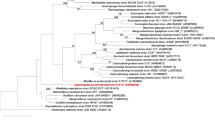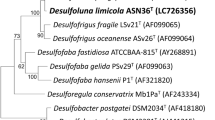Abstract
Enrichments on succinate plus yeast extract under anoxic conditions from intertidal mud-flat sediments yielded cultures dominated by oval to round-ended rod-shaped cells. Strain 10succl, obtained in pure culture, was characterized in detail. The non-motile cells possessed a gram-negative cell wall and did not form spores. Carbohydrates were fermented to formate, acetate, ethanol, and lactate. Succinate was decarboxylated to propionate. Other organic and amino acids were variously fermented to formate, acetate, propionate, and butyrate. Sulfur, sulfate, thiosulfate, and nitrate were not used as electron acceptors. Growth required the presence of yeast extract and at least 5 g/l NaCl, and was possible only in the absence of oxygen. No cytochromes were detected. The DNA base ratio was 40 mol% G+C. Phylogenetically, strain 10succ1 is closely related toPropionigenium modestum, as revealed by 16S rDNA analysis, but is physiologically distinct. Accordingly, strain 10succ1 (DSM 9537) is described as the type strain of a new species of the genusPropionigenium, P. maris sp. nov.
Similar content being viewed by others
References
Bradford MM (1976) A rapid and sensitive method for the quantitation of microgram quantities of protein utilizing the principle of protein-dye binding. Anal Biochem 72:248–254
Breznak JA, Switzer JM, Seitz HJ (1988)Sporomusa termitida sp. nov., an H2/CO2-utilizing acetogen isolated from termites. Arch Microbiol 150:282–288
Brulla WJ, Bryant MP (1989) Growth of the syntrophic acetogen, strain PA-1, with glucose or succinate as energy sources. Appl Environ Microbiol 55:1289–1290
Chaney AL Marbach EP (1962) Modified reagents for determination of urea and ammonia. Clin Chem 8:130–132
Collins MD, Lawson PA, Willems A, Cordoba JJ, Fernandez-Garayzabal J, Garcia P, Cai J, Hippe H, Farrow JAE (1994) The phylogeny of the genusClostridium: proposal of five new genera and eleven new species combinations. Int J Syst Bacteriol 44:812–826
Cord-Ruwisch R (1985) A quick method for the determination of dissolved and precipitated sulfides in cultures of sulfate-reducting bacteria. J Microbiol Methods 4:33–36
Dehning I, Stieb M, Schnik B (1989)Sporomusa malonica sp. nov., a homoacetogenic bacterium growing by decarboxylation of malonate or succinate. Arch Microbiol 151:421–426
Del Dot T, Osawa R, Stackebrandt E (1993)Phascolarctobacterium faecium gen. nov., spec. nov. a novel taxon of theSporomusa group of bacteria. Syst Appl Microbiol 16:380–384
Denger K Schink B (1990) New motile anaerobic bacteria growing by succinate decarboxylation to propionate. Arch Microbiol 154:550–555
Felsenstein J (1989) PHYLIP-phylogeny inference package (version 3.2). Cladistics 5:164–166
Galivan JH, Allen SHG (1968) Methylmalonyl coenzyme A decarboxylase. Its role in succinate decarboxylation byMicrococcus lactilyticus. J Biol Chem 243:1253–1261
Gorny N, Schink B (1994) Hydroquinone degradation via reductive dehydroxylation of gentisyl-CoA by a strictly anaerobic fermenting bacterium. Arch Microbiol 161:25–32
Guangsheng C, Plugge CM, Roelofsen W Houwen FP, Stams AJM (1992)Selenomoanas acidaminovorans sp. nov., a versatile thermophilic proton-reducing anaerobe able to grow by decarboxylation of succinate to propionate. Arch Microbiol 157:169–175
Hilpert W, Schink B, Dimroth P (1984) Life by a new decarboxylation-dependent energy conservation mechanism with Na+ as coupling ion. EMBO J 3:1665–1670
Janssen PH (1991a) Characterization of a succinate-fermenting anaerobic bacterium isolated from a glycolate-degrading mixed culture. Arch Microbiol 155:288–293
Janssen PH (1991b) Isolation ofClostridium propionicum strain 19acry3 and further characteristics of the species. Arch Microbiol 155:566–571
Janssen PH (1992) Growth yield increase and ATP formation linked to succinate decarboxylation inVeellonella parvula. Arch Microbiol 157:442–445
Janssen PH, Harfoot CG (1990a) Isolation of aCitrobacter species able to grow on malonate under strictly anaerobic conditions. J Gen Microbiol 136:1037–1042
Janssen PH, Harfoot CG (1990b)Ilyobacter delafieldii sp. nov., a metabolically restricted anaerobic bacterium fermenting PHB. Arch Microbiol 154:253–259
Janssen PH, Schink B (1993) Pathway of anaerobic poly-(-hydroxybutyrate degradation byIlyobacter delafieldii. Biodegradation 4:179–185
Jukes TH, Cantor CR (1969) Evolution of protein molecules. In: Munro HN (ed) Mammalian protein metabolism, vol. 3. Academic Press, New York, pp. 21–132
Kumar S, Tamura K, Nei M (1993) MEGA: molecular evolutionary genetic analysis, version 1.0. Pennsylvania State University, University Park
Liesack W, Finster K (1994) Phylogenetic analysis of five strains of gram-negative, obligately anaerobic, sulfur-reducing bacteria and description ofDesulfuromusa gen. nov., including theDesulfuromusa kysingii sp. nov.,Desulfuromusa bakii sp. nov., andDesulfuromusa succinoxidans sp. nov. Int J Syst Bacteriol 44:753–758
Maidak BL, Larsen N, McCaughey MJ, Overbeek R, Olsen GJ, Fogel K, Blandy J, Woese CR (1994) The ribosomal database project. Nucleic Acids Res 22:3485–3487
Matthies C, Schink B (1992) Fermentative degradation of glutarate via decarboxylation by newly isolated strictly anaerobic bacteria. Arch Microbiol 157:290–296
Neefs JM, Van de Peer Y, De Rijk P, Chapelle S, De Wachter R (1993) Compilation of small ribosomal subunit RNA structures. Nucleic Acids Res 21:3025–3049
Ollivier B, Cord-Ruwisch R, Lombardo A, Garcia JL (1985) Isolation and characterization ofSporomusa acidovorans sp. nov., a methylotrophic homoacetogenic bacterium. Arch Microbiol 142:307–310
Osawa R, Fujisawa T, Mitsuoka T (1992) Characterization of gram-negative anaerobic strains, isolated from koala feces, which exhibit satellite growth and pleomorphism. Syst Appl Microbiol 15:628–635
Pfennig N (1978)Rhodocyclus purpureus gen. nov., sp. nov., a ring-shaped, vitamin B12-requiring member of the familyRhodospirillaceae. Int J System Bacteriol 28:283–288
Platen H, Schink B (1987) Methanogenic degradation of acetone by an enrichment culture. Arch Microbiol 149:136–141
Scheifinger CC, Wolin MJ (1973) Propionate formation from cellulose and soluble sugars by combined cultures ofBacteriodes succinogenes andSelenomonas ruminantium. Appl Microbiol 26:789–795
Schink B, Pfennig N (1982)Propionigenium modestum gen. nov., sp. nov., a new strictly anaerobic, nonsporing bacterium growing on succinate. Arch Microbiol 133:209–216
Stackebrandt E, Goebel BM (1994) Taxonomic note: a place for DNA-DNA reassociation and 16SrRNA sequence analysis in the present species definition in bacteriology. Int J Syst Bacteriol 44:846–849
Trüper HG (1994) Taxonomic note: names for the higher taxa and their impact on the code of nomenclature of bacteria. Int J System Bacteriol 44:368–369
Author information
Authors and Affiliations
Corresponding author
Rights and permissions
About this article
Cite this article
Janssen, P.H., Liesack, W. Succinate decarboxylation byPropionigenium maris sp. nov., a new anaerobic bacterium from an estuarine sediment. Arch. Microbiol. 164, 29–35 (1995). https://doi.org/10.1007/BF02568731
Received:
Accepted:
Issue Date:
DOI: https://doi.org/10.1007/BF02568731




